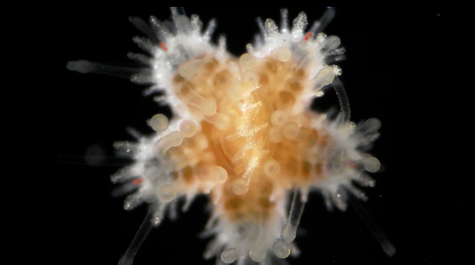You didn’t see this on ‘Spongebob’: Cannibal sea star babies
Karina Brocco French explains that sea stars are like butterflies: They go through metamorphosis.
“They start out as adults on the sea floor, and they look like what you expect a starfish to look like,” she said. “And they spawn, and then those little embryos end up flying through the water, if you will, during a larval stage where they look like weird little spaceships.”
The weird little spaceship stage lasts around a month, Brocco French said, before they metamorphose into juveniles, settling onto the sea floor. Jon Allen said the juveniles are essentially pinhead-sized, star-shaped versions of their parents.
 To grow, the juveniles must eat, and Brocco French and Allen discovered that what the young sea stars eat often turns out to be each other. Cannibalism is widespread in nature, but their discovery marks a heretofore unknown example of cannibalism in marine invertebrates fresh out of metamorphosis.
To grow, the juveniles must eat, and Brocco French and Allen discovered that what the young sea stars eat often turns out to be each other. Cannibalism is widespread in nature, but their discovery marks a heretofore unknown example of cannibalism in marine invertebrates fresh out of metamorphosis.
Their findings are described in “Cannibalism of newly-metamorphosed juvenile sea stars,” recently published in the journal Ecology. Allen is an associate professor in William & Mary’s Department of Biology. Brocco French is a Ph.D. student at the University of California, Irvine. She is a 2016 William & Mary graduate, and the research was conducted while she was an undergraduate member of Allen’s marine invertebrate lab. Their study animal is Asterias forbesi.
“This is our good old Virginia starfish. It goes from New England to the Gulf of Mexico,” Allen said. “So if you found this starfish on the Eastern Shore, it would likely be the one Karina and I were working on.”
And if you pick up one of these starfish, there’s a good chance that your beach souvenir ate one or more of its siblings at a very early age. Allen and Brocco French recorded cannibalism among the sea stars as early as four days post-metamorphosis.
“I’m convinced that if they could, they would eat each other during the little spaceship phase,” Brocco French said. “But unfortunately, I don’t think they have the ability to do that until they turn into little bitty sea stars.”
Allen said the larval sea-star spaceships eat unicellular algae, but “when the spaceship lands, the juveniles on the bottom eat the larvae.” The star-eats-spaceship behavior was documented earlier by other researchers, he added.
The juveniles are so much bigger than the larvae that this form of cannibalism was not surprising. But when juvenile-eats-juvenile action occurs, a sea star is taking on a meal roughly the same size as itself. Brocco French explains that sea stars feed in a manner that is totally different from how it’s depicted on “Spongebob Squarepants.”
“They extrude their stomachs, kind of like turning it inside out like a plastic bag,” she said. “And then they sort of engulf whatever it is they're trying to eat, and start to break it down, and then absorb the broken-down stuff. So they don't need teeth or anything. They've got it covered.”
Allen adds that a sea star has multiple stomachs; the one Brocco French describes is known as the cardiac stomach. “Instead of putting their food in their mouth, they slide their stomach out of their mouth into their food,” he said.
Their observations show that even minute differences in size can delineate the difference between the dinner and the diner. The bigger ones always seem to eat the smaller ones.
The duo’s interest in the teeny young cannibals began with a fortuitous disaster in the invertebrate lab.
“This started out as a totally different project, as Karina probably remembers painfully,” Allen said. “We were going to be culturing these juveniles to look at their reaction to predatory crabs, and whether the sea stars change their behavior in response to predator cues from the crabs. But they all started eating each other before we even introduced the crabs. So we had to scrap that experiment.”
They turned their attention to the more interesting phenomenon of sea star cannibalism, behavior that for the most part had escaped notice among the scientific community.
Allen said that in evolutionary context, sibling cannibalism provides an adaptive advantage to the individual sea star, especially when you consider the inevitable competition that results when a female Asterias produces five to ten million eggs each year. They began their paper by noting that cannibalism is common in the animal kingdom, the practice documented in more than 1,300 species, vertebrates and invertebrates alike.
Brocco French and Allen suspect that cannibalism is even more widespread. It would make sense that future research would reveal that previously unsuspected cannibalistic behavior is common among small animals and animals in early growth stages, like their sea stars. Allen says he hopes the Ecology paper will represent an “aha! moment” for researchers to look closely at the wide range of microscopic life for additional examples.
“We think — anthropomorphizing — that cannibalism is terrible. No one should be cannibalistic, ”he said. “But in nature, ‘red in tooth and claw,’ this is something that can be favored. So it seems to be a strategy that's likely to be common.”















